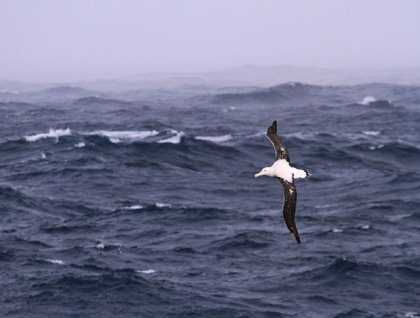It is such an incredible spectacle to see the world’s largest flying bird, the fabled wandering albatross, cruising effortlessly over a choppy sea. As one approaches head-on, its wings arc as if sagging under their own weight. They shudder occasionally in the turbulence, recalling those of an airliner. An equally rewarding experience is seeing the look of excitement and disbelief on the faces of those who are witnessing this graceful bird for their first time. I imagined what the aft deck of our ship looked like from the seabirds’ perspectives: a row of smiling faces, cheeks pressed against an impressive assortment of cameras. During squalls of hail and snow, punctuated by brief and sudden bursts of blue sky and sunshine, we practiced seabird photography on the sundeck. Our team of very talented photographers provided advice during and after this session.
The bird species tally for the today was an impressive 15 species, including five species of albatross: light-mantled sooty, southern royal, wandering, grey-headed, and back-browed. Marine mammal sightings were infrequent, probably due to the choppy seas obscuring our view. Nonetheless, we were treated to a brief glimpse of the stunning hourglass dolphin. The hourglass dolphin has the southernmost range of any dolphin species and it is endemic to Antarctic waters. Whale blows were also spotted, however they could not be identified to species level given the poor sea conditions.
As the evening light gradually softens, we continue to head south, across the ecological boundary to Antarctica: the Antarctic Convergence Zone. This is where the sea temperature will shift abruptly from 7 degrees Celsius to about 2 degrees (44 to 35 Fahrenheit) over the course of a few miles. The excitement and anticipation of seeing penguins, seals and whales will make sleeping a little challenging… but perhaps the soothing rolling of National Geographic Explorer will win out and lull us to sleep.







